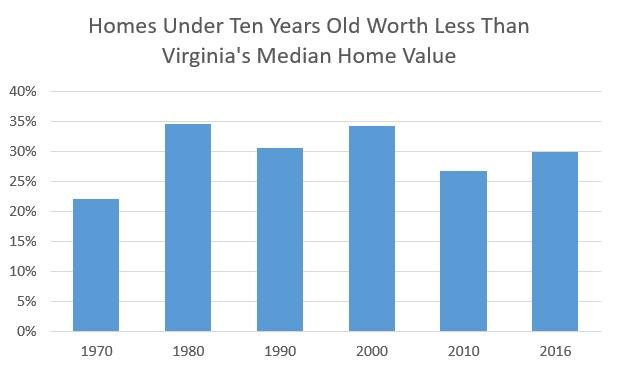Affordable housing is more scarce now than during the housing bubble
As the economy has strengthened in recent years, home prices have risen in much of the U.S., with the median home sale price recently passing its pre-recession peak. Virginians who rent are also spending more of their income on housing than during the 2000s housing bubble. Though household incomes in Virginia have been increasing since the end of the recession and currently are at an all-time high, the median rent in Virginia has risen three times as quickly as income over the past ten years. Among Virginian’s who are in the second from the lowest income quartile (households earning between 35 and 75 thousand dollars), the share spending more than the HUD recommended limit of 30 percent of their income on rent has continued to climb since the recession, reaching 41 percent last year, nearly double prerecession levels. Likely due to the high cost of housing and rent, the share of young adults between ages 18 and 34 who live with their parents or other relatives has also continued to rise since the recession, passing 45 percent last year.

One seemingly obvious cause of the scarcity in affordable housing is that not enough affordable housing is being built. Census housing data does show that only 30 percent of homes built in the last ten years are worth less than Virginia’s median home value. However, this is not a new trend, new housing typically costs more than older housing. Data from past censuses shows that a fraction of homes under ten years old have been worth less than Virginia’ median home value in previous decades as well.

Still, the overall decline in home construction following the recession has had a significant impact on Virginia’s housing. Even after factoring in Virginia’s slower population growth, more than 40,000 homes need to be built annually to house new residents and replace housing lost each year. New home construction has not been above 40,000 in Virginia since 2006 and has averaged around 28,000 over the past ten years. Based on housing data from past censuses, even if home construction in Virginia returns to above 40,000 annually, only about 30 percent of the new homes would likely be priced below Virginia’s median home value. That would make a small impact on the shortage of affordable housing.

On the longer term, however, an increase in new home construction could help alleviate the affordable housing shortage. As housing stock ages, it typically becomes more affordable, so a greater number of new homes can eventually result in a greater number of affordable homes. Economists use the term “filtering” to describe this process. In 2014, Stuart Rosenthal, a professor of economics at Syracuse University, published the most thorough analysis of the filtering process to date. One of his key findings was that a higher rate of new home construction will speed up the process of filtering, though the process still can take decades.

In Virginia, where fewer new homes are being built, census data shows that many of Virginia’s older homes are not depreciating in relative value as quickly as in past decades (particularly in Northern Virginia), indicating that the filtering process has slowed. This lines up with Rosenthal’s analysis that found filtering is typically slower in regions with rapid home price increases and low rates of new home construction. Rising home prices and a limited supply of new homes often encourages investors and home buyers to demolish or renovate older homes that might otherwise have become low income housing.
The idea that today’s luxury apartments could in a few decades be affordable housing is little comfort to Virginians currently overburdened by rent or living with family or roommates out of necessity rather than choice. The share of Virginians overburdened by rent has risen for over a decade. It could take just as long to return to prerecession levels.


